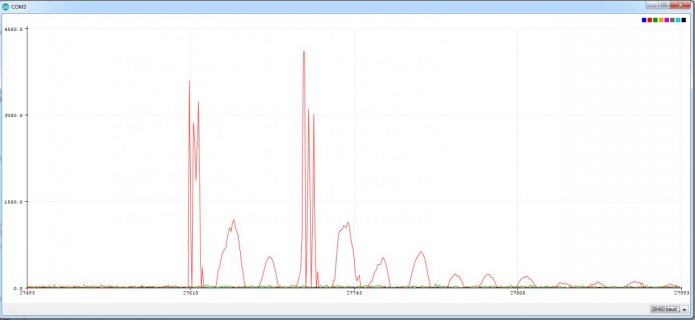Hi all,
I'm making an electric drumset using basic piezos and a teensy 3.2. I've got it working well enough for slow playing, as long as I adjust some variables to ignore piezo activity in between notes, but I'd like to be able to play fast as well. My setup is close to this for each piezo:
https://forum.pjrc.com/threads/2779...puts-explanation?p=65150&viewfull=1#post65150
The only difference with my setup and that diagram is that I don't use zeners at all, and I have a high-resistance resistor splitting the input signal and sending part of it directly to ground. I was hoping that putting the resistor there would reduce noise overall and also would make the piezo stop bouncing so much, but it isn't working quite as effectively as I was hoping (although, maybe I should try lower-ohms?)
There are a couple ways I've been trying to approach this through software, each with it's own issues:
1) Delay between notes: This works, but I want to be able to play pretty fast, and my teensy misses notes if I wait very long after each strike to start analogRead()-ing again. If I make this value too small I get false triggers, too large I get skipped notes.
2) Increase my minimum read value: This also works, but while I can play very fast after doing this, I also have to hit the pad pretty hard. I don't really want to be wailing on this drumset all the time cause it will wear down pretty fast and because I want to be able to make the drumset velocity sensitive at some point, and I don't really want my softest sound to come from a hard strike on the pad
My current thought is, perhaps there is a way to reduce the "bounce" caused by a piezo? If I could reduce the "after-shocks" of triggering the piezo significantly, then I'd be able to wait for less time between notes before reading again, as well as be able to reduce the minimum analog reading that I'm willing to process (so I could process softer sounds too). I'll attach an image so you can see what I mean about the after-shocks. Note that this image is of a double-strike with a drumstick, so there are supposed to be two peaks, just not like, 12 peaks

I'm making an electric drumset using basic piezos and a teensy 3.2. I've got it working well enough for slow playing, as long as I adjust some variables to ignore piezo activity in between notes, but I'd like to be able to play fast as well. My setup is close to this for each piezo:
https://forum.pjrc.com/threads/2779...puts-explanation?p=65150&viewfull=1#post65150
The only difference with my setup and that diagram is that I don't use zeners at all, and I have a high-resistance resistor splitting the input signal and sending part of it directly to ground. I was hoping that putting the resistor there would reduce noise overall and also would make the piezo stop bouncing so much, but it isn't working quite as effectively as I was hoping (although, maybe I should try lower-ohms?)
There are a couple ways I've been trying to approach this through software, each with it's own issues:
1) Delay between notes: This works, but I want to be able to play pretty fast, and my teensy misses notes if I wait very long after each strike to start analogRead()-ing again. If I make this value too small I get false triggers, too large I get skipped notes.
2) Increase my minimum read value: This also works, but while I can play very fast after doing this, I also have to hit the pad pretty hard. I don't really want to be wailing on this drumset all the time cause it will wear down pretty fast and because I want to be able to make the drumset velocity sensitive at some point, and I don't really want my softest sound to come from a hard strike on the pad
My current thought is, perhaps there is a way to reduce the "bounce" caused by a piezo? If I could reduce the "after-shocks" of triggering the piezo significantly, then I'd be able to wait for less time between notes before reading again, as well as be able to reduce the minimum analog reading that I'm willing to process (so I could process softer sounds too). I'll attach an image so you can see what I mean about the after-shocks. Note that this image is of a double-strike with a drumstick, so there are supposed to be two peaks, just not like, 12 peaks


